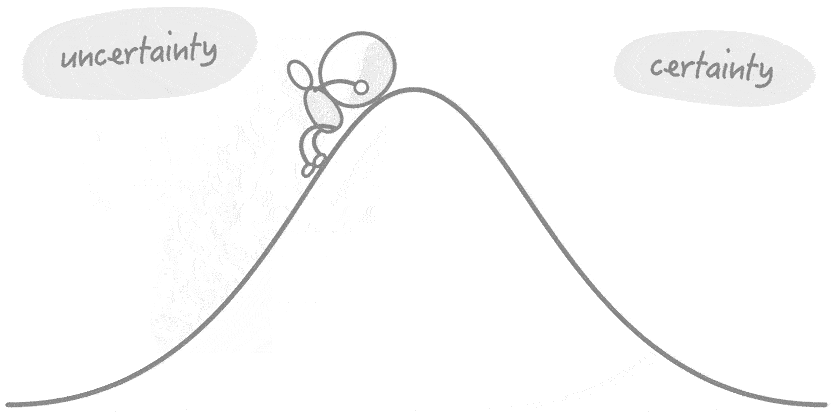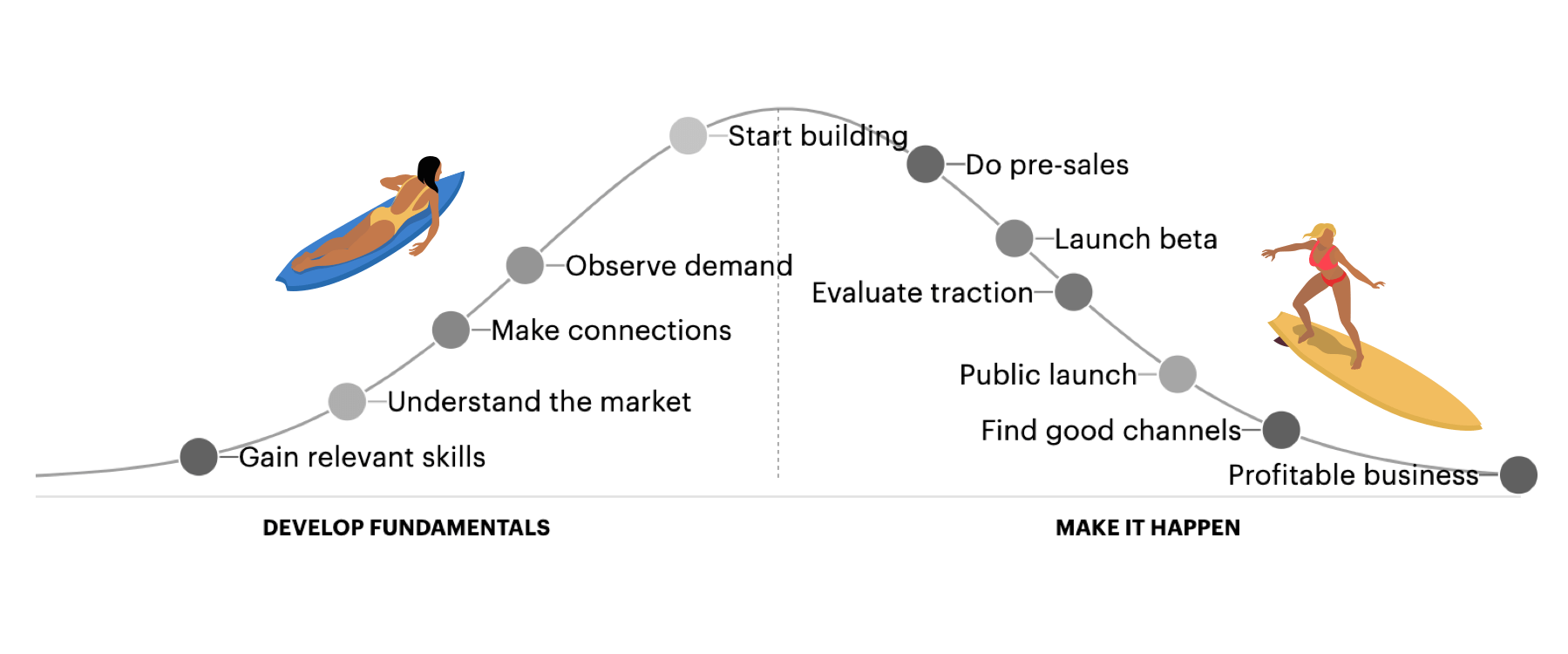Business is like surfing
Business is like surfing: the founder paddles out past the break, sits on their board, and evaluates the waves (the business opportunities) coming in. Specifically, they'll observe the size, shape, and momentum of customer demand.
Once they see a wave that looks promising, they'll start paddling so they can catch it. As they catch the opportunity, they'll feel the wave's energy lift and start to propel them.
It's the wave's power (the momentum of the market) that carries the founder forward. The founder needs to work hard at the beginning to catch the wave, but once they're on top of the wave, it's the wave producing the primary energy needed.
The founder steers and maneuvers their board (the product) to where the wave (the market) offers the most power and speed.
How long a founder rides a wave is determined by its intrinsic energy, other surfers (competitors), the weather and surroundings (external events), and their skill in riding the wave where it has the most momentum.
Business (and surfing) for beginners
Surfing is usually frustrating for beginners, largely because your first steps don't look like surfing.
Your first step is to focus on the underlying fundamentals. Before they can surf waves, beginner surfers have to spend time getting familiar with their board, practicing maneuvers, learning to paddle, and observing waves.
A beginner is uncertain of their abilities; they feel like an imposter. But as they improve their grasp of the fundamentals, they work up to the point where they can confidently catch waves.
You can visualize this process with a hill chart (courtesy of Basecamp):
The same is true in business!
Before you try to start a company, you should work on your fundamentals.
Using the same hill chart model, we could illustrate the process of building a business like this:
There are two stages of the process:
The "Developing Fundamentals" stage of entrepreneurship
Gaining relevant skills: This could mean learning how to code, design, market, sell, copywrite, and provide customer service.
Making connections: Much of business success occurs from who you know. You can meet people by going to meetups and conferences, interviewing them on a podcast, on social media sites, and starting a newsletter (more ideas here).
Understanding a market or industry
Observing demand
The "Making it Happen" stage of entrepreneurship
Starting to build the product
Doing pre-sales
Launching a beta
Evaluating traction
Doing a public launch
Finding good marketing and acquisition channels
Hiring the right people
Entrepreneurship and surfing are inherently difficult: not everyone who hops on a surfboard becomes a good surfer! And it will be exceptionally harder if you try to jump ahead without first developing your fundamentals.
How to develop your business fundamentals
Nathan Barry (founder of ConvertKit), taught himself web design at age 16, worked for a startup when he was 19, launched an iOS app shortly after that, and then (at 22) built an audience and sold a course on web app design. His current company, ConvertKit, is doing $20 million a year in revenue. He launched it when he was 23 years old.
You might be wondering: "How can someone so young (born in 1990) have built such a successful company?" There are certainly many factors, but one thing is clear: Nathan developed some strong fundamentals early on.
Don't skip the developmental stage! The skills you learn, the people you meet, the audience you build, the industry knowledge you gain, and the problems you observe will all influence your chances for success.
Spend some time paddling
"Surfing is 90% paddling and 10% surfing. The best surfers are always the best paddlers." – Joe Wilson, The Quiver
Surfers spend most of their time paddling. The paddling stage is important because it gives them a feel for the water, and how it moves. They learn to read the waves by being in the water.
Likewise, before they started their business, most founders spent a lot of time paddling.
What does this look like? Learn everything you can about a specific industry. If you're an employee, gain as many crossfunctional skills as you can. Consulting is also a great way to work with a variety of clients. You can also participate in online communities, go to local meetups, and meet people in other cities.
All the while, keep your eyes open for opportunities:
What products and services do companies in your industry buy?
What trends are coalescing into larger market movements?
What product categories are picking up steam?
How are purchasing decisions made?
Many of my entrepreneurial friends discovered their business idea while working for someone else.
For example, my friend Francois was doing web development consulting for Shopify stores. He noticed that many of his clients started requesting the same type of image gallery. So, instead of building it custom for everyone, he built it as a SaaS.
While you're paddling, you're trying to figuring out which business to start. You don't want to choose just any opportunity, you want to wait for the right wave.
Picking the right wave (choosing your market)
"Water transmits energy, and waves are the result of energy passing through water." – Octavia Drughi, Surf Camps
If business was surfing, the market would be the wave. Ultimately, your product's potential is determined by the size, momentum, and characteristics of your market. How much energy is in the wave?
It's only after you pick your market that you'll be able to answer these questions:
what product will you build?
who wants this now?
how much will they pay?
how will you position your product for this audience?
how will you reach them?
what's the size of the economic opportunity?
The strength of your market's "pull" (the size of your wave) is dictated by how many people want a solution, and how much they'll pay for it.
But what about your product? Isn't building the right product crucial for success?
The product is a lot like the surfboard: it's important, but only if you’re able to catch a good wave. (Surfing doesn't work when the water is flat).
"Picking the right market is really one of those durable pieces of advice. Even if you build the wrong product in the right market, that's many times better than building the right product in a wrong market." – Jeff Meyerson, on Software Engineering Daily
Surfers follow waves; entrepreneurs respond to customer demand.
In the beginning, it probably doesn't make sense to spend much time thinking about positioning, sales and marketing. These things are important, but only if you’ve first identified the right opportunity.
The way you position your board is important once you're riding a wave. But, positioning won't help your product if there's no demand.
You don’t want to ride a wave that’s too big, that’s way beyond your ability. But more than anything, you don’t want to ride a wave that’s too small. And, you definitely don’t want to be left sitting on your board in flat water.
What makes a good market
As entrepreneurs, we respond to existing demand, we don’t create it. The market should already be “pulling” for what you’re building; the demand should already exist.
Factors to consider when evaluating market demand:
Current market value = number of potential customers x how much they spend x the frequency at which they buy
Growth rate = current market value x growth rate (increase in # of customers, spending, frequency)
Market reach = can you reach a reasonable number of potential customers? Are there good marketing channels?
Competition = what competitors are you going up against? (How many people are gunning for the same wave?) Do you think you can compete at their level?
Demand grows on its own. It's influenced by a variety of factors until it reaches a tipping point, at which point companies can build things to satisfy that demand.
Being the right entrepreneur for the job
You're like a surfer, looking for rising tides. And you're not just sizing up these waves based on how they look, but also if you think you're the right person to ride them. Your personal characteristics matter: what skills, experiences, and connections do you bring to the table?
Choosing the right market is just the first step!
After that, there are a variety of factors that will influence your success:
Who you know, and who knows you
Your personal history + skills
Your financial margin
How you execute on the product
How you position the product
How you execute on marketing channels
If two competitors hop on the same wave, but one has more experience surfing than the other, the more skilled surfer will likely win the contest.
Building the right product
To succeed, you need to build a product that offers an outcome that is highly desirable to a hungry group of customers.
This is why the wave you ride matters. There should be preexisting, visible demand for your product category; especially if you're bootstrapping!
April Dunford (who has an awesome book), advises against trying to create a new category:
"A market category, once created, exists in the minds of buyers. It represents a group of solutions: CRM, email automation, smart glasses, etc. If you are a new startup, trying to grow while simultaneously defining a new category is one of the hardest ways to get initial traction. You don't have the resources to define it and survive."
She also describes what sets certain products apart (what makes them successful):
"Every successful product has a unique point of view. The iPhone is a good example. A highly differentiated product, launched in an existing category."
The shape of your product will determine how well it rides the wave of the market. Some surfboards are better for mellow waves, others are better for large swells.
You build your product so that it matches the pull of market demand. Previously, I've described it like this:
Eliminate obstacles in their path.
Give them progress at work.
Provide them with status.
Generate good feelings.
Remove future threats.
Bestow superpowers.
Take away friction.
When there’s sufficient demand for a product you can feel it.It feels like the market is pulling you (as opposed to you trying to pull the market over to your product).
Final thoughts
Catching waves is about patience. You’ll need good timing, skill, and effort. The perfect wave won’t just come to you either: you’ll need to be actively looking. Can't see a good opportunity where you are? Paddle to a new spot.
Also, if you're just starting out, you can begin by surfing smaller waves. That's OK! Launch a small project, put it out in public. Aim to earn your first dollar of business revenue.
Don't get impatient! Not every wave that comes your way is a good opportunity.
What I’m trying to do is give you principles that will increase your chance for success. I can describe the fundamentals of surfing, but I can’t guarantee you’ll catch the perfect wave.
But, if you spend time developing your fundamentals, and learn the characteristics of a good market, your chances of success will go up.
Good luck!
Cheers,
Justin Jackson
PS: is taking venture capital the equivalent of a Seadoo pulling a surfer in so they can ride a giant tsunami?


